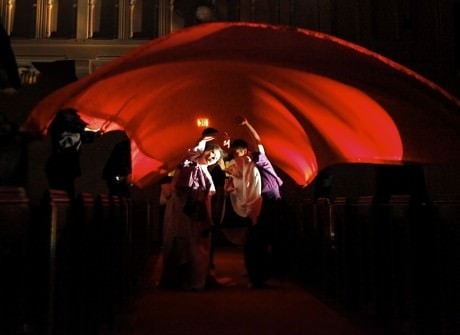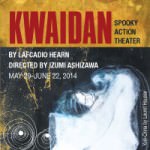Welcome back to the conversation and The Playwright’s Playground, an in-depth conversation with female playwrights in the DC theater community. Female theatre artists make up more than 50 percent of those involved in the theatre, yet the number of female playwrights being produced is dramatically lower. In this continuing Interview Series, I will introduce DCMTA readers to the many talented playwrights in the DMV area to learn about their writing process, their inspirations, and the motivations and struggles to write and produce their art.

Izumi Ashizawa. She’s bold. She’s impressionistic, and she demanding of your attention. The artistic stylings, reputation, and international acclaim of Izumi Ashizawa is that of a woman of many talents and of one who wears many hats. Izumi is a director, a performance artist, a costume designer, a puppeteer, a dramaturg, a choreographer, and she is a playwright. This 2010 winner of The Kennedy Center’s American College Theater Festival Faculty Achievement Award (Dreams in the Arms of the Binding Lady) and recipient of a Capital Fringe Director’s Award is also an Assistant Professor of Directing and Devised Theatre at State University of New York-Stony Brook and holds Masters degrees in English Literature from the University of the Sacred Heart of Japan and Dramaturgy from the Yale School of Drama.
It is my delight to share with you an enlightening and ‘spirited’ conversation with the Japanese born and raised Ashizawa who is the Co-Writer and Director of Spooky Action Theater’s interactive production of Kwaidan, currently playing at The Universalist National Memorial Church until June 22.
Part I: Izumi Ashizawa & The Art of Kwaidan: The Origins and Building of a Production.
Izumi guides us through the interdisciplinary collaborative process of physical storytelling and the adaptation of Kwaidan.
On Friday in Part II: Izumi Ashizawa – The Inspirations and Passions of a Japanese Interdisciplinary Artist.
The instinctive insights of Izumi are explored as she discusses playwriting and the origins of her visual style, the motivations of her work ethic and the personal impact of a life dedicated to art.
________
Sydney-Chanele: Many are unfamiliar with Kwaidan, especially since it has never been performed theatrically in this version before. But for those who have seen the foreign film, what is the difference between what one will experience with your site specific, interactive theatrical presentation and the film version of Kwaidan?
Izumi: I think it’s the direct connection with the audience and the performer. With this production the audience will feel it, breath in it, and emotionally attach to it. That type of immediate connection is there. If they choose, they can actually stand right next to the characters and stare into their eyes. This (experience) is like peeping in on someone’s life.
How has your playwriting informed your direction with Kwaidan?
This was an extremely collaborative process. Richard (Richard Henrich, The Artistic Director of Spooky Action Theater) and I did the playwriting together. The last version of the text is his writing. I started to write the structure of the play first and then based on that Richard added and changed. It’s really a combination of us and it’s an adaptation.
Who brought the project to whom? How did that collaboration begin?
I really like Kwaidan – all the ghost stories and spirits – and the idea of Shinto is always in my past works. Richard actually contacted me two years ago because he had seen my former performance /production Dreams in the Arms of the Binding Lady – a story based on Japanese folktales about a spider. He thought that the atmosphere and my approach to storytelling using physical action would be quite suitable for Kwaidan. He has wanted to do Kwaidan for a long, long time, and found that my vision would be the kind of vision he had with a similar language that he was seeking for the production. So that was the very beginning.
How familiar were you with Kwaidan before adapting and directing this production, and what elements of your past productions did you incorporate?
Very familiar. Folklore, mythology, the approaches of magical realism, puppetry, masks, and live chanting (with a non-western score) are all trademarks of my works.
Magical Realism, and live chanting with a non-western score, so how have you used those elements in Kwaidan? What you mean exactly by ‘live chanting with a non-western score’? The non-western style approach is that we don’t use any kind of recorded score; we just basically build. We build the chanting score out of exploration through the physical experimentation. So that’s something I have been doing for a while. In Kwaidan, in the beginning, the live chanting was improvisational but after one or two days the ‘scores’ become stable. Then that is the score. It’s an organic process that is decided by the actors.

Where did you acquire this style and technique in your theater background?
I have a Noh Theatre background. Noh Theatre is the oldest form of Japanese Theatre. It’s a movement in minimalism and stylization, and that idea and philosophy of Kata. The translation of Kata is form. Every single movement is already decided – like with martial arts, Japanese tea ceremonies and flower arrangements. In all Japanese art we start with Kata and end with Kata. Instead of approaching from psychology – which is the Western form – I approach from outside Kata and get into the psychology later. So it’s the opposite, a reverse approach to the characterization and the scene. So that’s part of the big influence of Japanese traditional theatre. Everything is based on physicality and the philosophy of Kata. How did you come up with the concept of using the entire church to stage this approach?
After Richard approached me and I came here and saw the church. I immediately felt that I wanted to use the entire church for the production. So from the very beginning I asked – can I use the entire church for Kwaidan? This production is really a devising theatre approach. The church is the big character and we created the script based on this church (The Universalist National Memorial Church.)
What was the process of incorporating the methods of Devised Theatre into your production?
First, we had several sessions with the actors before hand. Whenever I have new actors that I have never worked with before, I have a physical training session. We had training sessions in September and early November. Then we did intensive training in March. The March training was more production oriented. We didn’t do blocking, but I did a lot of experimentation, thinking about what I wanted to use in the production – which I did.
During those times I became accustomed to the space. No text was written at that time. I started this with nothing at all, but the space inspired us. We had done the casting but we didn’t know who was going to do what. Take me through the writing process of Kwaidan.
The script and everything evolved from the space and from the actors – a truly organic experience. That’s how I usually approach work. Research happened much earlier. The writing is a guideline of what kind of path we’re going to use, where we are going, and what story we are going to use. I started to pick a part the novel – this character says this . . . let’s put this part here … use this tale … From the very beginning we wanted to have Lafcadio Hearn, the writer character (the author of Kwaidan), as a guide to connect these stories and interact with the characters in the story. That’s the relationship and the exploration I started.
In January and February of this year, Richard and I are developing more and more with the material and the actors to get the script into a stable form. So the final version – and all the dialogue – that’s Richard’s world.
How many drafts did it take to write the script?
The first edition was November of last year … then there was a second, third, fourth, fifth. I would say there were six drafts in total. This is a really a site specific performance so we have to write down where we start, how to walk, and which story we are going to tell … and how.
With fairy tales there are usually underlying lessons or themes. What are the lessons to be learned from the Kwaidan tales? Do you have a favorite Kwaidan tale?
It’s part didactic, but not like a western fairy tale. Some of the tales are based on Buddhist teachings and some are based on Shinto teachings. It’s a basic idea of respecting nature. Also, there is always a promise with a lot of tales that you see in our performance and something that you are forbidden. The main character always breaks that promise. So that breaks the balance. And I think that’s really critical – teaching that common idea throughout the ghost stories in Kwaidan.

Well, I like all of them but I like “Yuki -Onna” – The Snow Woman. Yuki- Onna is about a human relationship – and a promise broken – and the relationship with human beings and nature. Shinto religion beliefs intertwined with the human love story is quite interesting. Some people might say it’s just a simple ghost story but I think it’s a relationship. These two characters truly loved each other. There is subtleness in it and it’s beautiful that way.
Do you have any interest in writing your own spooky tales?
I would love to. It’s one of the reasons why l did Kwaidan. Right now, I am also intrigued to create a play for children based on Japanese supernatural that is a little bit contemporary with the westernization in Japan using a lot of mystical creatures not the ghosts this time but the spiritual creatures.
Kwaidan promises to be such a unique and interactive journey. What is the takeaway experience you want for audiences?
I would like them to think about it and experience with full feeling. After that contemplate what it really meant. There are many different layers that we are using. For example, why are we using a Neo-Gothic church? We don’t hide it. We intentionally show all of it. Then there are Japanese characters acting in this space. So it’s two juxtapositions of cultures happening at the same time. Why is it? The guide is The guide is Lafcadio Hearn, so it’s through his perspective, and he represents the audiences’ perspective. If the audiences end up wanting to read more about Kwaidan and Lafcadio Hearn that would really be great because he’s not that acknowledged by American people. If audiences become curious about Japanese culture and start to read, and then get more interested . . . that would be so great!
______
As part of the Kwaidan run, SAT will be offering a FREE screening of Kwaidan (donation suggested), the 1964 movie also based on Lafcadio Hearn stories, and a talk-back with Michael Dirda, a Fulbright Fellowship recipient and a Pulitzer Prize–winning book critic for the Washington Post.
Directed by Masaki Kobayashi, Kwaidan the movie consists of four separate and unrelated stories: The Black Hair, The Woman of the Snow, Hoichi the Earless and In a Cup of Tea. The screening will be hosted by Michael Jeck, adjunct professor of film history at George Mason University and note writer for Film Forum Rep, NY, since 1991.
Author of the article The Ghost Stories of Lafcadio Hearn, Michael Dirda will moderate a talk-back between the Kwaidan ensemble and the audience.
Kwaidan (1964)
Directed by Masaki Kobayashi
Hosted by Michael Jeck
June 14, 2014 Sat @ 3:00 PM
Talk-back with Michael Dirda
June 15, 2014 Sun @ 4:30 PM
Kwaidan plays through June 22, 2014 at Spooky Action Theater performing at The Universalist National Memorial Church-1810 16th Street, NW, in Washington, DC. For tickets, call (202) 248-0301, or purchase them online.
LINKS
Meet the Cast of Spooky Action Theater’s ‘Kwaidan’: Part 1: David Gaines and Tuyet Thi Pham.
Izumi Ashizawa’s Website.
Other interviews in The Playwright’s Playground.
My review of Kwaidan on DCMetroTheaterArts.






